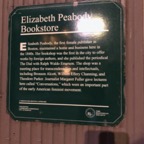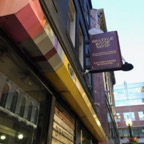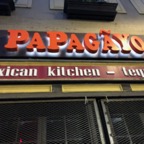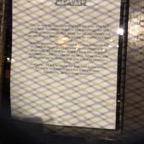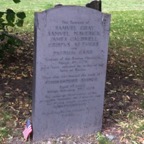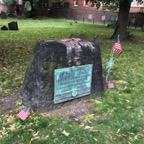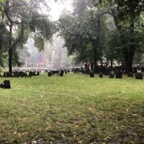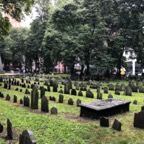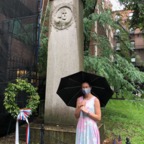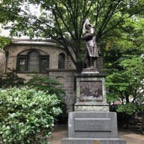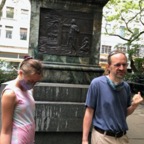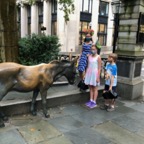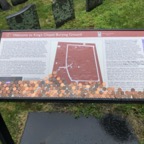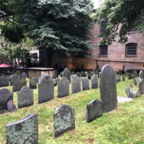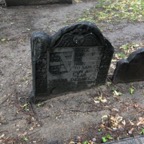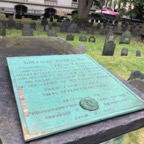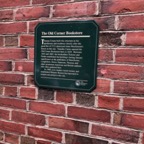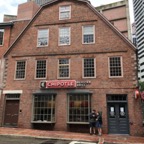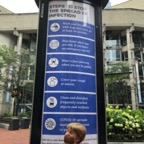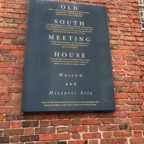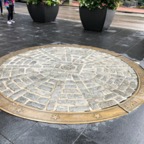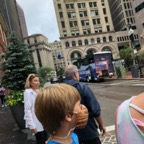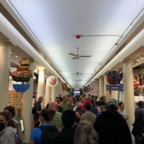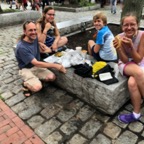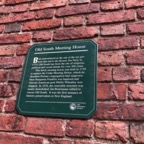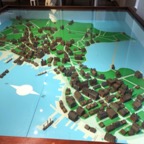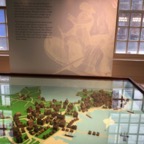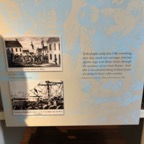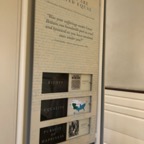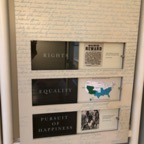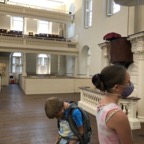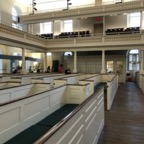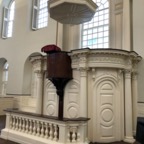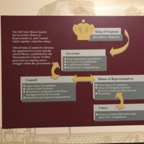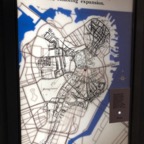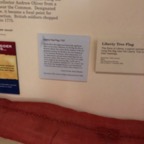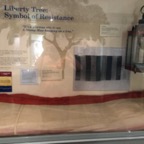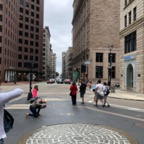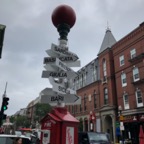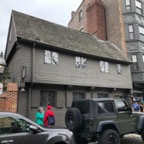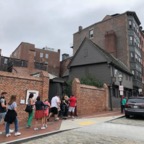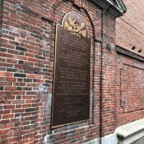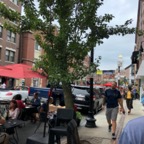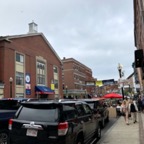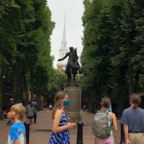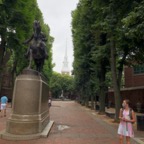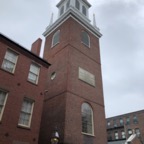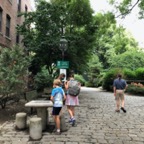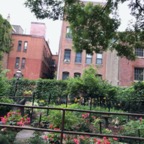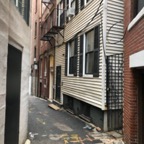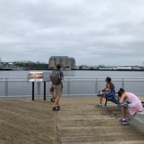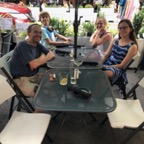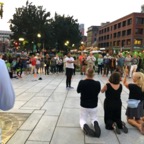Boston: Freedom Trail
On our first full day, we did a big walking tour of Boston: the Freedom Trail. We wanted to get a historical overview of Boston, with a sense of its historic places and locations, and also get a feel for how Boston is laid out both then and today.
We’d downloaded an app the night before which would walk us through the Freedom trail, and we also got a booklet from a little kiosk in the Common. Mike and I did a lot of explaining from our own store of knowledge as well (which is more engaging than reading from a booklet).
It’s funny – I’d been to Boston a number of times as a teenager and adult, because my sister Leslie has lived here since the late 1970’s (and Boston was always my first stop when coming from France), but I had almost no sense of its layout because I’d never had to navigate it as an adult. You don’t have to pay attention to what things are where until you need to figure it out for yourself.
So I learned a bunch of things right away, like the fact that Boston used to be a peninsula, and that that fact played a role in the American Revolution, as the little neck of land connecting Boston to the mainland could be cut off (and was). Also, when Paul Revere (and those two other guys that everybody forgets because they weren’t in the poem) did their famous ride to tell the countryside whether the Redcoats were coming “by land or by sea” the information they were bringing was whether the Redcoats were going to march southwest over the peninsula to the mainland around Roxbury, or to take boats north, across the mouth of the Charles River, and land in Charlestown instead.
We started the walk at the Common, visiting Colonial, Revolutionary, and post-Revolutionary sights there, like the Massachusetts State House and the Park Street Church, then walked a few blocks to the Granary burial ground. Samuel Adams, John Hancock, are buried here, as well as members of Benjamin Franklin’s family, and many other prominent figures.
At this point in our day it began to pour. I mean, REALLY pour. It was like a bucket of water was being up-ended over each of our heads. And it was chilly. We were not dressed for this, as we were in summer clothes and hadn’t thought to bring jackets. The difference in weather from the previous day (when it was warm and beautifully clear) to today when it was grey, chilly, and pouring cats and dogs, was startling. I was quite forcibly reminded of how big the weather swings can be elsewhere in the country. In California the weather just doesn’t change that much in the summer: it’s either hot and clear and dry, or hotter and clear and dry. The temperature drops about forty degrees at night (which does startle newcomers) but that nighttime swing doesn’t affect the daytime temperatures. For a good six months we don’t wear jackets or carry umbrellas or anything ‘wintery’ like that, and even that clothing is basically for ‘spring’ or ‘fall’ in Boston.
It also reminded me of why there had been so many people outdoors the day before. There had been people and families everywhere, strolling in the Common, sitting on benches, sitting or laying on the grass. It really was a lot of people sitting about, doing not very much. Reminded me a bit of the lounge chairs along the harbor in Oslo, Norway, where people were just laying back soaking up the sun.
My sister told me of an insight she’d had after living in Massachusetts for several years: beautiful weather is so much rarer in Massachusetts that when it DOES happen, lots of people drop everything and just go outside to enjoy it. And this, she believes, is why people sometimes think that nobody gets any work done in California: people know that the weather is beautiful in California for much of the year, so doesn’t that mean that Californians respond in the same way they do, and just go out doors to enjoy it? So they stop working too? For much of the year? So they must not get anything done?
The reality is of course that Californians DO get stuff done, they just keep working right through the beautiful weather because beautiful weather isn’t a scarce thing. You put your nose to the grindstone during the week even if it is gorgeous outside. You can relax more on the weekends, confident that it will ALSO be beautiful outside then.
Anyway, Mike ran back to the apartment to grab our jackets (it was only a couple blocks away), while we huddled under umbrellas in the Granary burial ground.
Once we were properly dressed, though we had a fair amount of water UNDER the jackets, which was not the TEXTBOOK way to handle rain, we explored the burial ground, found the famous graves, and talked a lot more about the colonial period, the Revolution, and what it meant.
Then we visited the Boston Latin School, which had been founded in 1653, which was the first public school in America. That’s only a couple decades after the pilgrims, a generation or two. One of the themes that we were discovering and emphasizing was how fast Massachusetts was settled, with big strides taken every generation.
We backtracked a bit to the King’s Chapel burying ground, where we talked about the history of the Puritans vs. the Anglican Church vs. the Catholics. There was the original split with the Catholic Church in England under Henry VIII, followed by Queen Mary’s disorienting whiplash back toward Catholicism, then Queen Elizabeth’s forging on an uneasy Protestant compromise which lowered tensions between Catholics and Protestants. Her path ultimately gave rise to the Anglican Church (which of course doesn’t recognize the Pope and has a lot of Protestant doctrine, but also many Catholic forms). This compromise wasn’t Protestant ENOUGH for a more radical wing of the Protestants, though. They wanted England’s state religion to be farther away from Catholicism, more pure (in their view). These folks became the Puritans, and some of them came to the New World a couple decades later as the Pilgrims.
The King’s Chapel, meanwhile, was the first ANGLICAN church to be built in New England, in 1686, which was kind of an uncomfortable thing if you think about it, and the mostly-Puritan surrounding population was not happy with this. This let us talk about the uncomfortable relationship between Puritans and Anglicans over here, and back in England.
We found several famous graves in the burial ground by the church – though the burial ground actually predated the church and was not affiliated with it (the Anglican founders of the chapel just grabbed a bit of the burial ground to build their church on, because none of the Puritan landholders would sell them land). Interestingly, there was an obscure gravestone here, to an Elizabeth Pain, which is said to be Hawthorne’s inspiration for the character of Hester Prynne in the Scarlet Letter.
We visited the Old Corner Bookstore, which was the home to a famous publisher who printed many now-famous American works, like the Scarlet Letter, the Midnight Ride, and the Atlantic Monthly magazine. It is now a Chipotle’s, which is kind of a comedown. But this did let us talk about the difficulty of preserving historic buildings, and particularly how to pay for their preservation.
We have a similar situation with one of the Cooper-Molera house in Monterey, which was closed for years due to lack of funds, but is now re-opened to the public because they brought in a restaurant. The lease brings in the money flow to support the building and lets the public in again too. So, mixed feelings, but this is not a bad compromise. It is better than tearing it down.
Then we got lunch in Faneuil Hall – a covered food court a few blocks away. It was VERY crowded, with a number of unmasked people, which felt like a total people bath and was kind of unnerving. Owen, as you will remember, was not yet vaccinated. We scouted it out, split up, and got a number of different lunch items from different vendors before retiring to eat them on a bench outside. Getting local food is one of the ways that we experience and enjoy a place, and we got dishes like clam chowder as well as several sandwiches and chili to share. We tend to share everything: everybody gets a couple bites of each item, then we pass them on (rather like the Mad Hatter’s Tea Party), so that everybody gets to try everything.
Then we visited the Old South Meeting House! This was a big destination: it was the site of the tax protests that led to the Boston Tea Party in 1773! It was the site of religious, political, and social debate for centuries. We went inside, visited the museum, and talked at length to a docent there to get all sorts of information about it. And I learned a lot about the history of Boston itself, which was extremely helpful.
Then we walked to Little Italy, and passed the sight of the Boston Massacre. We visited the museum to learn more about the event. The museum exhibit dug down to as close as it could get to what actually happened that day, and then also explored how the event was re-told, embellished, and changed (especially in a famous illustration of the event) to get people even more riled up against the British in the period leading to the revolution.
We saw the Old North Church after that, where the lanterns were lit to indicate whether the Redcoats were coming by land or by sea. It was closed due to the pandemic unfortunately, but we got a good look at the outside.
We finished with a visit to Paul Revere’s house, which was also fascinating – I learned a lot of local, human details about Paul Revere and his house and family. And the museum also had an exhibit about how Longfellow’s poem became the accepted version of Paul Revere’s ride, even though it omitted and changed a number of details. Very interestingly, Paul Revere gave three accounts of his ride himself (which differ a bit between the tellings, as personal stories often do). The museum had an exhibit of Paul Revere’s own accounts, laid out on a map, and another exhibit about the poem, which were neat to read and compare. It’s always interesting to dig down through the telling of history, deeper and deeper through layers of stories, until you get to what you HOPE are the facts, but even then you realize that this, too, is a personal story told by someone who is now gone. But it’s the best that you can get.
After visiting Paul Revere’s house we finished by walking all the way to the Charles River. It had been a HUGE day, with miles of walking and multiple museums and LOTS of history to absorb.
We rounded it off with dinner outdoors at an Italian restaurant in Little Italy, which was delicious! We were all really glad to sit down, take a load off, and enjoy a good dinner.
Then we walked back, stopping to enjoy some street performers on the way, until we got to our place, where we basically collapsed for the night.
